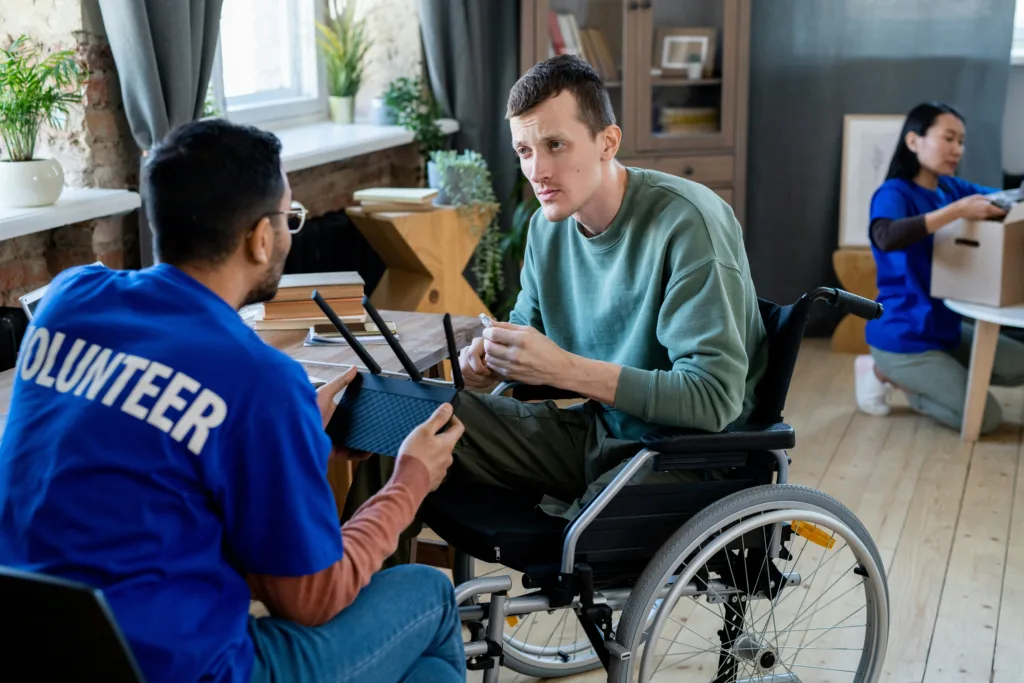
The Robertson Trust was established in Scotland in 1961 by the Robertson sisters – Elspeth, Agnes and Ethel – who donated their shares in the family whisky business (now operating as the global company Edrington), founded and developed by their grandfather and father, to the Trust for charitable purposes.
Jim McCormick, CEO of The Robertson Trust, and Dom Llewellyn, co-founder of their discovery stage advisers AchieveGood in 2022-23, discuss the genus and implementation of a social impact investing carve-out of up to £20M.
Can you give a brief overview of The Robertson Trust?
Jim: The Robertson Trust is an independent grant-maker for Scotland, just over 60 years old. It is quite unusual in that the Trust is the principal shareholder in Edrington, the global premium drinks company. So we do not just have a historic endowment like many foundations – we benefit from an operating surplus dividend from the global business that we can use to cover much of our annual charitable expenditure as well.
In recent years, share transactions have generated additional capital beyond the dividend, placing even more responsibility on us to have a clear and responsible investment policy for our pooled investments which currently total over £400M.
How did you first come to the idea of investment for impact?
Jim: In the autumn of 2020, the Trust committed to a new strategy for this decade to build solutions to poverty and trauma, each affecting around one in five of the population in Scotland, and a higher proportion when including those most at risk.
We look to do that work through grant-making and by supporting capacity building and creating platforms for our partners and grant-holders to use their voices to advocate for change. But we also thought there could be some strong opportunities for alignment through social impact investing (SII).
Given The Robertson Trust’s scale and its genuine independence, we realised that if we were not involved in social impact investment, we would be operating with one hand tied behind our backs. Previously, there had been a small number of social investments made in quite an opportunistic way and without any specific strategy around them so the creation of the new strategy around poverty and trauma seems a good time to be more structured and intentional. However, we knew we did not have the capacity to take on SII in-house, given everything else we had to urgently work on. So we took the decision in spring 2023 to source outside expertise.
In seeking that external expertise, what were you specifically looking for?
Jim: We were looking for a track record in understanding a fast-changing landscape. We wanted independence of thought and capacity that was not too aligned with anyone particular school of thought or operating model. We also wanted to build our comparative knowledge – working with someone who knows enough about Scotland but is also able to draw upon evidence from elsewhere.
It took us a year to get to the point of appointing Achieve Good to work with us. While it has not been a quick process, it has been thorough.
Dom – Who are AchieveGood and what were your first steps in supporting The Robertson Trust?
Dom: AchieveGood is a UK-based organisation help forward-thinking public, private and social sector organisations grow their social, environmental and financial impact. We do this primarily through catalysing partnerships between governments, foundations, businesses, and social sectors. We tend to do this through place based activities, corporate partnerships and social impact investing. Our team have built over £800m ($1bn) worth of partnerships in social and environmental impact.
As Jim said in the spring and summer 2023, The Robertson Trust went out to tender for some advisory work to support them in an options appraisal, with the intention to then create a social impact investing strategy.
For the options appraisal, we looked to get different perspectives across the Trust and really work out what the ambition was. At that point we talked to a number of organisations that had trodden this path before like Joseph Rowntree Foundation, Guy’s and St Thomas’ Foundation, Church of England, Big Society Capital and others.
The next phase was working on a strategy and setting up a governance structure with a new social impact investing committee that would act as a sub-committee of the main Board. We discussed what internal capacity and support would be needed and helped them identify some potential deal flow. In December 2023, Trustees agreed on the principles of having three pots of capital: concessionary capital, impact-first (with return of capital) and finance-first (targeting closer to the RPI+4% applied in the Trust’s Investment Policy).
In terms of deal flow, how did you source potential social impact investing opportunities?
Dom: For the impact-first investments, Jim was really clear on wanting to focus on the Trust’s four themes of Financial Security, Emotional Well-being and Relationships (which spans a further set of sub-themes including the early years and gender-based violence), Education Pathways and Work Pathways. These themes should be pursued via two cross-cutting areas: the Trust’s Climate commitment and equity, diversity, and inclusion (EDI) which is currently focused on advancing racial justice.
We looked at examples in Scotland and across the UK of potential social enterprises that could be receivers of investment. We also considered how we could help those enterprises to partner with fund managers and other intermediaries, recognising that if the Trust was going to implement this with a small team, partnership was crucial.
We wanted to find the right deals – not just the easy deals. But we also wanted to be able to tell a clear story and showcase internally and externally how The Robertson Trust could maximize its assets and drive real impacts aligned to its themes in Scotland and the rest of the UK through UK-wide funds.
What do you see as the main barriers deterring other foundations from taking an SII approach?
Jim: There are lag effects in this sector. There is a relatively small number of leading investment managers and advisers and therefore there is a high degree of correlation between funds held. So it is hard to see where the differentiation – and therefore the innovation – is coming from.
Another barrier is that impact investing is a bit chicken and egg: investment committees do not want to invest into these funds until they are proven. But how can funds prove themselves unless they have some early adopters? Another issue is share-of-fund. We have seen propositions that would be a very good fit for us, but it the risks of contributing one-third of funds under management tend to outweigh the opportunities – we and probably many others would rather be 10%.
These are very reasonable concerns. But we feel the external context is demanding us all to move faster which is why we have established an SII committee with external members who are fluent in how we can confidently go further and faster.
You mentioned equity was one of your two cross-cutting themes alongside climate change – what are the guiding pillars for that?
Jim: Our DEI work is called EDPR, which is equity, diversity, participation and rights, which we think is a tougher and more ambitious definition. As Dom said, that group has decided we should put racial justice as our primary focus at this point in our strategy. Next year, we will be broadening that out in an intersectional way.
We have driven that work primarily through our grant-making, analysing what our current footprint looks like, who is missing and does not know about us, what are we doing in terms of power and decision-making. We are also committed to looking for social enterprises with real impact potential that are led by and serving minoritised communities. We do not know enough about what those look like in Scotland, but we are committed to finding out and to working with people who do know.

Having gone on this journey with The Robertson Trust, what ingredients for success in social impact investing would you identify?
Dom: I would say you have got to have a chief executive like Jim who really believes in this and who wants to drive it forward. You have also got to have members of the board who are really passionate about it and want to see it happen.
So, for example, we were greatly assisted by Campbell Robb, a Board member of The Robertson Trust who had previously done a lot of this work as CEO of the Joseph Rowntree Foundation. And we had another senior board member who said that it was the second-most exciting thing he had done whilst being a board member of the Trust!
Also, everyone talks about board and governance almost as if they are homogeneous. But boards are not homogeneous in terms of the individuals and their perspectives and experiences. So creating a strategy and a structure that takes board members on a journey, and continues to do so, is also really important.
Is there an expiry date for the £20mn SII carve-out and could it be enlarged in the future?
Jim: We do not have an end-date, which is helpful as that allows us to go faster or slower in the different ‘pots’ as we find our feet. As to whether trustees see the carve-out as a kind of a demonstration project which may or may not have wider implications for the portfolio, the jury’s out to be honest.
Dom: A quote which I think you can attribute to Jim is “A trust or foundation just doing grant making is driving impact with one hand tied behind its back.” And I think the big question is how do you drive impact through your whole portfolio? That is absolutely crucial and I think Jim’s right, the jury is definitely out on that at the moment.
In three years’ time, what will be the vital signs of success for your SII carve-out?
Jim: First, we will hopefully have demonstrated that there are more than enough quality, investable propositions relevant to our mission and to Scotland. We will have worked out in the open so other trusts and foundations, and potential investees, will understand what we are doing and why. We will have shared appropriate learning. We will have been a net positive addition to the social investment ecosystem. The trade-off between risk and opportunity will have been decisively positive. There will be more confidence amongst decision-makers, i.e. boards, that this is a pathway to continue to follow with more scale and more ambition.
Most important of all, we will have some brilliant investees who will be able to do things that they would not have otherwise.
Dom: For me, two additional measures of success would be, first, that the £20mn carve-out is the beginning not the end of this journey. Second that we create a conversation internally and externally among stakeholders of how you effectively deliver impact through all your assets. Because in a free market, by definition, what people invest in becomes valuable. So how do you really drive impact through what you invest in? That is the conversation foundation leadership needs to have.
